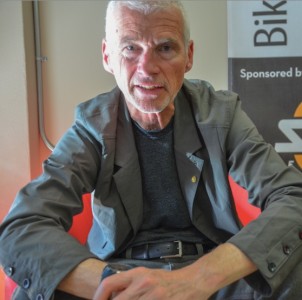
Central City Multimodal Safety Project, stopped by the
BikePortland office for a chat Tuesday.
(Photos: M.Andersen and J.Maus/BikePortland)
Rick Browning is already a big part of Portland as we know it. His fingerprints are on everything from the streetscape reconstruction that helped make inner Alberta Street a regional destination to the transformational 1999 widening of the Hawthorne Bridge sidewalk to the bike path that leads straight into our airport’s terminal.
This morning, he started a job working on one of the most significant bike projects of his career: one or more protected bike lanes across downtown Portland.
As we reported earlier this month, downtown is probably the most bike-intensive part of the city that has almost no all-ages bike infrastructure. But what else will the project include, and how will he help the city navigate the many obstacles to change? We sat down with Browning Wednesday night for an advance look at his idea of his mission, the decisions he’ll need to help make and whether downtown bike infrastructure should be a priority at all.
BikePortland: The description of this project has been a little vague. What do you know so far about its scope?
Rick Browning: You may know more about the scope of the process than I do. That was not a big part of the selection process. I think the big concepts still need to be ideated.
My understanding of the project is that Portland has sort of plateaued on mode split. You guys have run some articles over the last few years on that. We’ve come so far — it’s incredible. But it’s exactly where all the national polls predicted we would be. We’ve been doing these polls for 20 years; the results are very consistent among a majority of Americans. They would like to ride — for work, for errands — but they don’t feel safe. My goal is to help that larger percentage of people feel that they can ride.
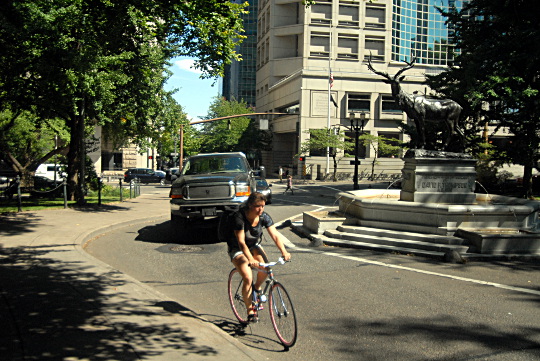
What do you see as the main challenges before you?
Obviously the challenge in the downtown is just the constrained nature of the downtown. Everybody’s aware of that. What tradeoffs will need to be made to find more space for bike and, to some degree, pedestrian modes?
“We all want to make our city a more enjoyable, more livable, safer place and better for biking and walking. I think it would be wrong to not do those things because we’re afraid of gentrification.”
I’m very impressed with the work Janette Sadik-Khan and company did in New York. I saw her speak a few weeks ago in Seattle. The work she did there in New York, I think everybody agrees is transformative. She didn’t just focus I think on what it did for bikes and pedestrians, she focused on what it did for businesses as well. She was also able to present percentage of increased retail sales for businesses adjacent to those projects. If we can do that here, I think that’d be fantastic. Not that that’s the primary goal, but I think we need all the friends we can. Sales have increased dramatically — she was talking about increases in sales of up to and over 100 percent on some of these installations. That seems like a win-win.
I’ve heard some people say Portland needs a new business association to represent the interests of businesses that benefit when streets are places to be rather than just places to move things quickly. Obviously you’re not going to engineer that, but if someone else were able to, how would that relate to your work here?
If this project is successful in the way we’re discussing, it becomes a demonstration project that shows what New York found, among other cities: that these kind of projects are actually good for business. Maybe that’ll create new momentum for businesses that are on the fence.
Again, that should not be the litmus test for this project. I don’t mean in any way to make it that. But if we can get the most bang for our buck, then we would all win.
Advertisement
Not that many people live in downtown, but —
I am one! I moved into the Ladd Tower. It’s a great place to live, but it was a deliberate choice. I’ve always found that the more you personally experience a place you’re trying to upgrade or design, the better. So I’ll be walking around and breathing it every day.
One thing about Sadik-Khan’s work is that it was happening in the teeth of a recession, and everybody was interested in jobs, jobs, jobs. These days I think the single biggest issue in Portland is rising real estate prices and displacement. On the way here today, I was riding down Third Avenue — it’s a surprisingly run-down street, with two-story buildings, a vacant lot in the middle of downtown. If we slow the speed and volume of traffic there, it’ll become a better place to sit on the sidewalk, which means it’ll be a better place for someone to spend $80 million. But on the other hand, the Silverado can afford to pay the rent in its old building, and that has cultural benefits. Do you see problems along those lines with improving these streets?
You’re talking about gentrification?
Yeah, or displacement.
That gets into a lot of other issues that the city confronts that are beyond cycling. We all want to make our city a more enjoyable, more livable, safer place and better for biking and walking. I think it would be wrong to not do those things because we’re afraid of gentrification. But I think we need a whole basket of policies.
Another thing is that lower-income people are more reliant, I think, on cycling and walking. Those are not the people that typically show up at city council hearings to encourage that sort of development and planning. But lower-income people that ride because they need to ride to get to work, that’s part of Portland too.
Do you have any thoughts on the big unanswered question of which north-south streets should be improved?
None at all. And I think that makes me kind of a good candidate for the job, because I’m not coming in with any preconceptions. And looking for maybe something that’s a little bit counterintuitive and outside the box.
I’m a designer and an architect. If you go in with fixed models and preconceived solutions, almost always you wind up with a weaker final product than being open to exploration.
Although, since I live on the Park Blocks … (laughs)
“The $6 million grant that I hear PBOT has is more per capita than, according to my calculations, Sadik-Khan had to work with in New York to do everything she did.”
How do you feel about the size of the budget?
When I saw Janette Sadik-Khan speak in Seattle, she had a pie chart that showed the overall transportation project New York had, I think it was over a three-year period. I did the math proportional to Portland’s population and New York’s population, and per capita the $6 million grant that I hear PBOT has is more per capita than, according to my calculations, Sadik-Khan had to work with in New York to do everything she did.
Of course, New York is now going back and trying to formalize some of those projects like Times Square, and they’re going to do stuff with concrete and permanent installations that are going to cost a lot more money. I’m going to go out on a limb here and say I don’t think we can remake the entire central city for $6 million.
Another thing we grapple with here is that downtown Portland is already a really nice place. And most of east Portland isn’t even safe. So how can we justify further investment in downtown?
I understand the concern, and have spent some time trying to ride a bike in far east Portland, so I know firsthand what motivates the comments. And I don’t have an easy answer to that. I might fall back on an aphorism I learned while living in Seattle for five years or so. In Seattle, every neighborhood has its own downtown, and in Portland, downtown is everybody’s neighborhood. I think that’s true. It’s not that there’s even that many people living downtown, but Portlanders in general will converge on downtown and use it. So to that degree is our most heavily used, most popular built environment resource. But that doesn’t mean other areas of the city shouldn’t also see investment.
I was reading in the Willamette Week bike issue that there’s a road diet planned on … is it Powell?
Foster.
Foster. I think it’s an example of a way that the city is dedicating a substantial resource to a sort of far-flung area, and indeed the budget for that is fairly close to what they have for the central city. Still, it shows there’s investment happening elsewhere and that’s the way it should be.
You don’t own a car now. Have you ever?
It’s been about eight years. And it really isn’t about car ownership, right? It’s about how much you drive the car. And I was not a big user ever. I get around on bike, foot, bus, car2go. It’s great to be back in a city with all these great transit options. For the last couple years I was living in Olympia.
Now that you’re back here, would you like to stay in Portland when this project wraps up?
I would. I want to enjoy the fruits of my labors. I hope my Seattle girlfriend will forgive me for saying that.

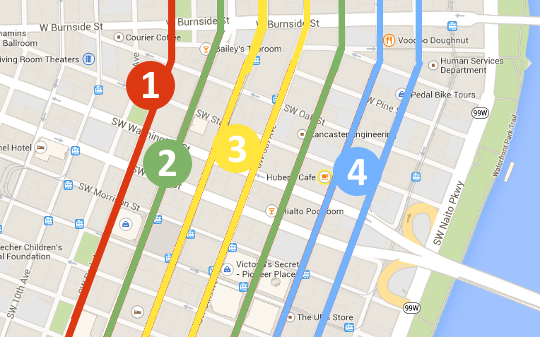
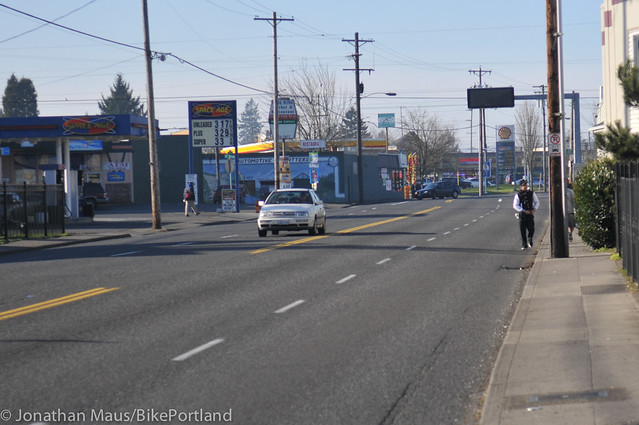

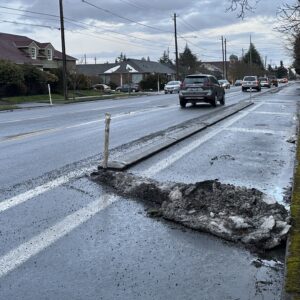
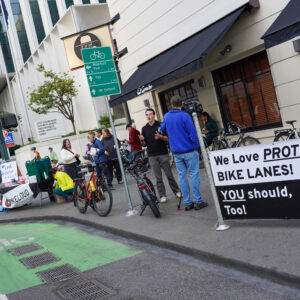

Thanks for reading.
BikePortland has served this community with independent community journalism since 2005. We rely on subscriptions from readers like you to survive. Your financial support is vital in keeping this valuable resource alive and well.
Please subscribe today to strengthen and expand our work.
Putting figures on anything at this point is bound to restrict future development. We need to be talking city-wide transformation, but we’re handed this milquetoast focus on two lanes downtown. Our city bike politics have gone flaccid.
*Googles milquetoast* …. Yep.
“In Seattle, every neighborhood has its own downtown, and in Portland, downtown is everybody’s neighborhood.”
ಠ_ಠ
Yes, I didn’t really get that line. Most neighborhoods in Portland have at least something resembling a center of commerce. In this way it’s actually not THAT different from Seattle.
One major difference is that in Portland these little neighborhood hearts seem to exclusively revolve around a single street (Hawthorne, Division, Woodstock, Alberta, Williams, etc.), where in Seattle they are a little more 2 dimensional.
And there are a LOT of people in this city who are not consistently going downtown.
Having live in Seattle, I totally agree with his comment. Each dense, urban neighborhood in Seattle is like a little city. If you live in Capitol Hill or Ballard, you don’t really have any reason to leave unless you work elsewhere–all your daily destinations are in walking distance.
Portland is not like that as much. Neighborhoods are more dispersed, and we generally have long main streets rather than centers of activity. That said, some people certainly never feel the need to go downtown, but downtown seems to be more of an attractor than in Seattle. In Seattle you usually only go downtown if you work there or you need to transfer from one bus to another. Maybe an occasional shopping trip, I suppose.
This meat of this project will be devoted to the political willpower to reallocate car parking space to bikes exclusively.
I hope the first strategy is reconfiguring travel lanes. On most of those streets there are 3 (or more!) travel lanes in each direction. This is unnecessary.
This is a good suggestion – but as a last resort only in my opinion. My first priority is to make a place for bikes in a place they are used to riding, at the side of the street, between pedestrians and moving motor vehicles. A wide, single-direction lane with newly-installed, highly-visible protection on one side and existing curb/sidewalk on the other.
Great interview, although I disagree with this sentence “Not that many people live in downtown”. 12,801 people live Downtown as of the 2010 census. In terms of residential population density it’s one of the densest neighborhoods in the entire city.
…but I love this sentence “Silverado… has cultural benefits”.
The 2nd & 3rd couplet is a bad choice because it is so far off towards one edge and it is down the hill from much of downtown. People are unlike to head down hilll to ride on one of those streets then backtrack up the hill to get to a destination on, say, 11th or 12th.
I’d love to see the park blocks used, with motor vehicles banned, but that might have to be a ban only at certain times of the day or days of the week to accommodate things like the PSU farmers market.
We live downtown. With all of the recent tragedies, Mrs Dibbly has been pleading with me to stop riding until there are infrastructure improvements. Is she being unreasonable? Probably, but not everything in life is rational.
Pending studies and so forth, gut feeling is that Park Blocks seem like the best idea to me, too. Doubly so if the Better Naito effort turns into a permanent fixture at some point (which further obviates 2nd/3rd). That seems like a good set of primary north-south routes as far as access and proximity.
How about ‘every lane is a bike lane’. Go big or go home.
+∞
Yes. Stripe all of the streets with only 5ft lanes which sometimes vanish or taper into a curb.
I need some help understanding how Park Blocks are a good idea. There’s a stop sign on almost every crossing with east-west streets and heavy ped use in this corridor.
I would look at placing these bike-specific lanes as near to the mean center of (working) population as possible. Because of the Wells Fargo Center, US Bancorp Tower, and Koin Center, i’d guess it’s about 4th Avenue.
3rd and 4th ave utilize existing traffic patterns, could link to Barbur & Terwilliger, and provide access to the biggest buildings and Willamette River bridges.
Thanks for the dialogue.
This is an exemplar of how well illustrated the articles at BikePortland are. The perfect photos for every part of the story; it’s so good that I’m not sure everyone notices it. Thanks, guys!
Seattle girlfriend? How many girlfriends does he have?!?!! A Portland one? San Francisco? LA? 🙂
Best of luck! For 6 million you could do Better Block demo projects on every street in downtown and then pick the ones that work the best/have most support.
Don’t forget about the girlfriend in the Niagara Falls region
You can never have too many girlfriends 😉
Until they start talking….
Looking forward to see how this project pans out. Can’t wait for a safe place to ride a bike downtown! Hoping that the plans also include cycle infrastructure at the base of the Hawthorne Bridge.
And from Tilikum Crossing, too. A lot of the Hawthorne Bridge traffic will move over there once it’s open.
Do you not think the facilities on SW Moody are safe?
I’d say the Tilikum Crossing has pretty great bike infrastructure either side of it. While not perfect, it would be very low on my list of things to fix.
SW Moody is already a fantastic cycle track and takes you nearly all the way to Waterfront Park.
This is not a fantastic cycle track. The mixing and crossing of pedestrians is terrible and to be expected when you share a sidewalk with some symbols on the ground. The transition into it with the jug-handle crosswalk is silly and the 2-way design only works with no intersections. I’ve only ridden it a dozen times, but I’m frequently miffed by the stop light timing at Sheridan (now add the pointless red light drills with the max tracks), biking single-file with no passing space, and almost always have a close call with a pedestrian. Taking the traffic lane with the streetcar tracks was actually rather pleasant by comparison. The section of bike lane on Bond is also useless, and I’ve been nearly doored or hit by a taxi each morning I’ve been on Whitaker.
Until Portland gets speeding in check, grows the spine to install diverters on greenways, and figures out how to paint continuous bike lanes of appropriate width, we should stop building nonsense like Moody which doesn’t have the capacity for the mode share we claim to need to support.
“Foster. I think it’s an example of a way that the city is dedicating a substantial resource to a sort of far-flung area,”
This kind of mentality has me worried that we won’t see much change even further east. If Foster (52nd-88th) is considered “far-flung” what do many in the central city consider deep sections of East Portland, well out in the hundreds?
the planned bike lane on foster does not meet pbot or odot standards for arterials with 35 mph speed limits (most collisions are fatal at this speed). at a minimum it should have been buffered or protected the whole way.
The *risk* of fatality to a pedestrian/cyclist at 35 mph is about 90% for a shared space (Wramborg graph, OECD). Providing the bike lane is one form of separation that decreases that risk. 30 mph with a separate bike space is the proposed PBOT standard. Higher posted speeds would need more separation – a buffer or placing the bike lane behind the parking lane, or up on the curb with pedestrians. I don’t recall if the current speed limit is proposed to be reduced.
SE Duke and Flavel east of 52nd fall into this category and have been requested for speed limit changes.
I don’t know that you got my point, but PBOT has continually mentioned reducing Foster to 30mph with the new streetscape.
Yes, we requested Duke and Flavel to be reduced to 30mph (crossing fingers that ODOT agrees). Woodstock should also be reduced.
i agree with your point about outer east portland needing more infrastructure. and i’m more than willing to pay highly progressive fees or increased taxes to help fund these improvement.
I think his point was that Foster is not “outer east portland,” and that the political perception that it is far-flung doesn’t help the real outer east portland. It’s closer to downtown than Kenton or Montavilla, but it get’s treated as some sort sort of backwater edge city.
As long as bikes don’t have to ride on sidewalks and IF THERE IS A BIKE PATH it is on the left side of a 1 way street, and wide enough that a cyclist would not be doored.
The most telling part of this interview is how much Portland is looking to NYC and other cities as examples of what to do next. This confirms that Portland is no longer the lead city in developing bicycle infrastructure. This is perhaps a good sign from the national perspective. Portland was far ahead of all other US cities for a long time, but now those cities are catching up and will almost certainly soon surpass Portland. In order to prevent them from doing so, Portland needs to step up its efforts quickly, but that doesn’t seem to be happening. A multi-year process for a single crosstown protected lane in downtown is pretty paltry compared to the large-scale low-stress networks planned for Seattle, DC, Minneapolis, and Atlanta(!).
The other cities are doing the same thing Portland has done, looking to Europe and importing translated versions of the tools Europe has already developed. The difference in US cities’ adoption of those techniques boils down to will and funding.
Have you seen the bike roundabout that only lets motorists go E-W while cyclists can go in any direction? Watch for versions on legacy greenways with traffic circles.
https://bicycledutch.wordpress.com/2013/08/26/experimental-bicycle-roundabout-in-zwolle/
As much as I want to see more protected bike lanes, downtown is the last place I would start. With the traffic signals timed for 12 mph on almost all downtown streets, it’s one of the safest places in the city to ride. Let’s get some decent, long cycle tracks on the east side where we’ve been having some serious accidents lately.
I don’t really feel like downtown is all that unsafe, but let’s get back to basic principles. Why does downtown even exist?
Companies (particularly tech) move into the city and buy up office space downtown because they assume that’s the best place to be. Meanwhile, the east side of the river is comparatively underdeveloped, resulting in far too much traffic concentrated in a few dozen small blocks west of the Willamette.
Maybe we need some incentives to spread this density out a bit, to provide jobs around the city instead of directing all commutes to a tiny, tiny fraction of the metro area.